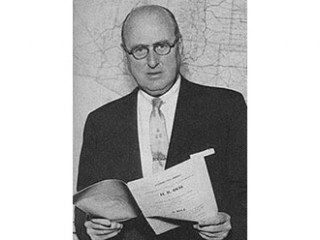
Clarence George Fallon biography
Date of birth : -
Date of death : 1950-01-11
Birthplace : Rockwood, Queensland, Australia
Nationality : English
Category : Politics
Last modified : 2011-03-25
Credited as : Trade union official, labour party, 'Yes' company
0 votes so far
He worked in the transport, mining and pastoral industries. Having joined the Trolley, Draymen and Carters' Union in 1908, he helped to form a sugar-workers' union in the Bundaberg district; he was also active in the Gladstone branch of the Railway Workers' Union and in the General Labourers' Union. On 11 March 1913 he married 19-year-old Lillian Matilda Sansum with Anglican rites at Christ Church, Bundaberg; they were to have five children. Fallon enlisted in the Australian Imperial Force on 18 September 1916, but was discharged in November because of defective vision. His brother Jack was killed in France in 1917.When he joined the Australian Workers' Union in 1917, Fallon was a municipal worker. By August 1921 he was a temporary organizer for that union at Bundaberg, 'gaining his first real insight into the manipulations of certain sugar employers to hamper the worker's progress'. In charge of the A.W.U. office at Rockhampton in 1923, one year later he transferred to Mackay where he developed a friendship with William Forgan Smith. Fallon rose quickly in the union hierarchy. He became northern district secretary at Townsville in April 1928 and in the following year narrowly won the presidency of the Queensland branch. From January 1933 until his death he was State secretary of the A.W.U.; in conjunction, he was managing director of the Queensland Worker, chairman of the Daily Standard and director of Labor's radio station, 4KQ. On 14 June 1938 he was elected secretary of the State branch of the Australian Labor Party. He pursued causes vigorously. After his son Jack 'a pilot in the Royal Australian Air Force' died in an air crash in 1937, Fallon attacked the 'hopeless inefficiency and inadequacy' of the R.A.A.F., and demanded an official investigation into its organization. Frequent criticisms directed at improving standards of air safety also appeared in the Worker. He later repeatedly called on the Federal government to strengthen inadequate defences in Northern Australia.
Vice-president (from 1933) of the A.L.P.'s Queensland central executive, Fallon succeeded W. H. Demaine as president in November 1938. Fallon's friendship with Premier Forgan Smith was then transformed into a political alliance that completely dominated the Q.C.E. until Forgan Smith's resignation in 1942. Good working relationships continued with successive Labor premiers, F. A. Cooper and E. M. Hanlon. In late 1942 Prime Minister Curtin attempted to persuade the A.L.P.'s State executives to support conscription for overseas service in a limited area of the South-West Pacific. The proposal, placed before the Q.C.E. with the support of Cooper, Hanlon and Forgan Smith, was opposed 'under instruction from the Queensland Delegates' headed by Fallon.From June 1938 Fallon had also been president of the federal executive of the A.L.P. During his term of office the party experienced one of its most turbulent periods. In August 1939 he chaired the unity conference convened to reform the New South Wales Labor Party led by J. T. Lang. In controversial circumstances surrounding the resignation of Edward Grayndler, Fallon was elected general secretary of the A.W.U in 1940. He intended to hold the position conjointly with his State secretaryship, and refused the salary of £2000. Eventually forced to choose between remaining in Queensland and moving to the national office in Sydney, he resigned as general secretary in February 1943 and supported W. B. Hay's candidature for the position. Tom Dougherty wrested the post from Hay in January 1944, weakening Fallon's power at the national level and creating a deep rift between the two. That year the Allied Works Council altered the working conditions of cooks in the Civil Construction Corps, without reference to the conciliation and arbitration process. In protest, Fallon resigned his presidency of the A.L.P.'s federal executive on 7 July. He remained convinced that Curtin's Labor government had compromised its principles and policies.
As Queensland director for the 'Yes' campaign in the 1944 referendum to give the Commonwealth fourteen new powers, Fallon made statements that were detrimental to the case.From his initial prominence in the 1929 South Johnstone sugar-workers' strike, Fallon had set an impressive record as an advocate in industrial matters. He represented the A.W.U. and many other unions in basic-wage cases, and worked long hours, often seven days a week. His commitment to A.W.U. affairs led him to refuse offers of alternative appointments, including that of industrial commissioner for Queensland, though in 1944 he agreed to become government representative on the senate of the University of Queensland. Nicknamed 'the red terror' as much for his intense opposition to communism as for the original colour of his hair' Fallon was 5 ft 10 ins (178 cm) tall, with a fair complexion, brown eyes and a resounding voice; he attributed his poor eyesight to sandy blight (trachoma) from his days as a bush worker. He demanded absolute loyalty from members and officials.
During his long stewardship the Queensland branch of the A.W.U. was noted for its cohesion. Colleagues remembered his decisiveness, and his unforgiving nature. First and foremost a Queenslander, he fiercely defended the principles of the labour movement, and tirelessly endeavoured to improve working-class wages and conditions.Survived by his wife, two daughters and two of his three sons, Fallon died of a cerebral haemorrhage on 11 January 1950 in North Sydney, on the eve of an A.W.U. convention, and was buried in Lutwyche cemetery, Brisbane.
















